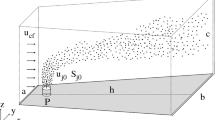Abstract
Implicitly implemented large eddy simulation (LES) with a fifth-order WENO scheme was conducted in this study. Based on Navier-Stokes equations, this LES was carried out to explore the origin of momentum deficit caused by a supersonic micro-ramp at flow conditions of M a = 2.5 and Re θ = 5760. The numerical results were validated through qualitative and quantitative comparisons with existing experimental data. After describing the aerodynamic properties of the supersonic wake, such as the deficit and the streamwise vortices, the momentum deficit was later detected to originate from the lower portion of the upstream boundary layer, while the high momentum fluid originated from close to the wall at the upper portion. Position alternation trigged by the micro-ramp was finally proposed as a revised mechanism.
Similar content being viewed by others
References
J. C. Lin, Review of research on low-profile vortex generators to control boundary-layer separation, Progress in Aerospace Science, 38(4–5) (2002) 389–420.
S. Lee and E. Loth, Supersonic boundary-layer interactions with various micro-vortex generator geometries, Aeronautical J., 113(1149) (2009) 683–697.
S. Lee, E. Loth and H. Babinsky, Normal shock boundary layer control with various vortex generator geometries, AIAA paper 2010-4254.
S. Lee, M. K. Goettke, E. Loth, J. Tinapple and John Benek, Microramps upstream of an oblique-shock/boundary-layer interaction, AIAA J., 48(1) (2010) 104–118.
H. Holden and H. Babinsky, Effect of microvortex generators on separated normal shock/boundary layer interactions, J. Aircraft, 44(1) (2007) 170–174.
H. Babinsky, Y. Li and C. W. PittFord, Microramp control of supersonic oblique shock-wave/boundary-layer interactions, AIAA J., 47(3) (2009) 668–675.
M. Rybalko, H. Babinsky and E. Loth, VGs for a normal SBLI with a downstream diffuser, AIAA paper 2010-4464.
Q. Li and C. Liu, LES for supersonic ramp control flow using MVG at M=2.5 and Reθ=1440, AIAA paper 2010-592.
Q. Li, Y. Yan, P. Lu, A. Pierce, C. Liu and F. Lu, Numerical and experimental studies on the separation topology of the MVG controlled flow at M=2.5, AIAA paper 2011-72.
Y. Yan, Q. Li, C. Liu and F. Lu, Numerical, Experimental and Theoretical studies on the mechanism of K-H instability and ring generation behind supersonic MVG, AIAA paper 2011-676.
Y. Yan, C. Chen, X. Wang and C. Liu. LES study on the mechanism of vortex rings behind supersonic MVG with turbulent inflow, AIAA paper 2012-1093.
Y. Yan, Q. Li, C. Liu, A. Pierce, F. Lu and P. Lu, Numerical discovery and experimental confirmation of vortex ring generation by microramp vortex generator, Appl. Math. Modell. (2012), doi:10.1016/j.apm.2012.01.015.
W. R. Nolan and H. Banbinsky, Characterization of the micro-vortex generators in supersonic flows, AIAA paper 2011-71.
Z. Sun, F. J. J. Schrijer, F. Scarano and B. W. van Oudheusden, The three dimensional flow organization in a supersonic boundary layer, Physics of Fluids, to appear.
C. Liu, L. Chen, Study of mechansim of ring-like vortex formation in late flow transition, AIAA paper 2010-4623.
L. Jiang, H. Shan, C. Liu and M. R. Visbal, Non-reflecting boundary conditions for DNS in curvilinear coordinates, Proceedings of the Second AFOSR Conference held at Rutgers, The State University of New Jersey, New Brunswick, U.S.A., June 7–9 (1999).
N. A. Adams, Direct simulation of the turbulent boundary layer along a compression ramp at M = 3 and Re = 1685, J. Fluid Mech., 420 (2000) 47–83.
Q. Li and C. Liu, Declining angle effects of the trailing edge of a microramp vortex generator, J. Aircraft, 47(6) (2010) 2086–2095.
Lu FK, Li Q and Liu C. Micro vortex generators in highspeed flow, Progress in Aerospace Sciences, 53 (2012) 30–45.
J. M. Oorebeek, W. R. Nolan and H. Babinsky, Comparison of bleed and micro-vortex generator effects on supersonic boundary-layers, AIAA paper 2012–45. C. S. Kim, K. S. Hong, and M. K. Kim, Nonlinear robust control of a hydraulic elevator, Control Engineering Practice, 13(6) (2005) 789–803.
R. S. Chandel and S. R. Bala, Effect of welding parameters and groove angle on the soundness of root beads deposited by the SAW process, Proc. of Trends in Welding Research, Gatlinburg, Tennessee, USA (1986) 479–385.
S. Kalpakjian and S. R. Schmid, Manufacturing processes for engineering materials, Second Ed. Addison-Wesley Publishing Company, New York, USA (1992).
Author information
Authors and Affiliations
Corresponding author
Additional information
Recommended by Associate Editor Donghyun You
Xiao Wang is a Ph.D. student at the Math Department of the University of Texas at Arlington, Texas, USA.
Rights and permissions
About this article
Cite this article
Wang, X., Yan, Y., Sun, Z. et al. LES investigation into the generation of momentum deficits in the supersonic wake of a micro-ramp. J Mech Sci Technol 28, 1327–1337 (2014). https://doi.org/10.1007/s12206-013-1164-x
Received:
Revised:
Accepted:
Published:
Issue Date:
DOI: https://doi.org/10.1007/s12206-013-1164-x




